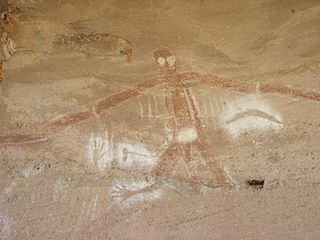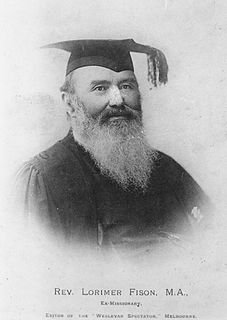Related Research Articles

In Australian Aboriginal mythology, Baiame was the creator god and sky father in the Dreaming of several Aboriginal Australian peoples of south-eastern Australia, such as the Wonnarua, Kamilaroi, Eora, Darkinjung, and Wiradjuri peoples.
In Australian Aboriginal mythology, Birrangulu or Birrahgnooloo is a goddess of fertility who would send floods if properly asked.
In Australian Aboriginal mythology, Yhi is a goddess of light and creation, and a solar deity. She lived in the Dreamtime and slept until a whistle awakened her. When she opened her eyes, light fell on the Earth. She walked the earth and plants grew where she walked. Soon the whole world was covered with foliage. She decided that, in addition to plants, she wanted to make something that could dance. Searching for such an organism, Yhi found evil spirits beneath the earth who tried to sing her to death. But her warmth chased away the darkness and insects of all kinds were created from it. She brought them to Earth and then found some ice caves in a mountain. She shined her light on the being resting inside and fishes and lizards came out, along with many other kinds of birds, mammals and amphibians. She then returned to her own world and blessed her creations with the change of the seasons and promised that, when they died, they would join her in the sky. When she disappeared, darkness came back and covered the Earth. The organisms thought she was not returning and were sad, but then came the first sunrise and Yhi returned.

Gunnedah is a town in north-eastern New South Wales, Australia and is the seat of the Gunnedah Shire local government area. In the 2016 census the town recorded a population of 9,726. Gunnedah is situated within the Liverpool Plains, a fertile agricultural region, with 80% of the surrounding shire area devoted to farming. The Namoi River flows west then north-west through the town providing water beneficial to agricultural operations in the area.

Barwon River, a perennial river that is part of the Murray–Darling basin, is located in the north-west slopes and Orana regions of New South Wales, Australia.

The Kamilaroi Highway is a 605-kilometre (376 mi) state highway located in the north-western region of New South Wales, Australia. The highway's northwestern terminus is at a junction with the Mitchell Highway at Bourke. Its southeastern terminus is a junction with the New England Highway north of Willow Tree.
Murri is a demonym for Aboriginal Australians of modern-day Queensland and north-western New South Wales. For some people and organisations, the use of Indigenous language regional terms is an expression of pride in their heritage. The term includes many ethno-linguistic groups within the area, such as the Kamilaroi (Gamilaraay) and Yuggera (Jagera) peoples.

The Shire of Balonne is a local government area in South West Queensland, Australia, over 500 kilometres (310 mi) from the state capital, Brisbane. It covers an area of 31,104 square kilometres (12,009.3 sq mi), and has existed as a local government entity since 1879. It is headquartered in its main town, St George.

The Gamilaraay, also rendered Kamilaroi, Kamillaroi and other variations, are an Aboriginal Australian people whose lands extend from New South Wales to southern Queensland. They form one of the four largest Indigenous nations in Australia. The Kamilaroi Highway, Sydney Ferries Limited's vehicular ferry "Kamilaroi" (1901–1933), and a cultivar of Durum wheat have all been named after the Kamilaroi people.

The Gamilaraay or Kamilaroi language is a Pama–Nyungan language of the Wiradhuric subgroup found mostly in south-eastern Australia. It is the traditional language of the Gamilaraay (Kamilaroi), an Aboriginal Australian people. It has been noted as endangered, but the number of speakers grew from 87 in the 2011 Australian Census to 105 in the 2016 Australian Census. Thousands of Australians identify as Gamilaraay, and the language is taught in some schools.
William Ridley was an English Presbyterian missionary who studied Australian Aboriginal languages, particularly Gamilaraay.

gurre kamilaroi or Kamilaroi Sayings was a manual of Biblical instruction for the Kamilaroi people in their own language, produced by William Ridley and published in Sydney in 1856.
Darkinjung is an Australian Aboriginal language, the traditional language of the Darkinjung people. While no audio recordings of the language survive, several researchers have compiled wordlists and grammatical descriptions. It has been classified as a language no longer fully spoken and it can be classified as needing a language renewal program. It was spoken adjacent to Dharuk, Wiradhuri, Guringai, Gamilaraay, and Awabakal. The Darkinjung tribe occupied a small part of southeastern Australia inside what is now the New South Wales area. They likely inhabited a considerable tract of land within Hunter, Northumberland, and Cook counties.

Lorimer Fison was an Australian anthropologist, Methodist minister and journalist.

Cryon is a parish and hamlet situated 685 km from Sydney, 130 km west of Narrabri and 52 km east of Walgett on the Kamilaroi Highway in the north-west of New South Wales, Australia, and lies in the Walgett Shire. The settlement sits at an altitude of about 146 metres. When the Walgett railway line arrived here in 1905 this was a thriving settlement with a variety of businesses including a hotel and stores. For quite a few years it was the loading point for cattle from South West Queensland that were railed to the Sydney market. The railway now only carries freight (grain).

Barnumbirr, also known as Banumbirr or Morning Star, is a creator-spirit in the Yolngu culture of Arnhem Land in Australia, who is identified as the planet Venus. In Yolngu mythology, she is believed to have guided the first humans, the Djanggawul sisters, to Australia. After the Djanggawul sisters arrived safely near Yirrkala in North East Arnhem Land, Barnumbirr flew across the land from East to West, creating a song-line which named and created the animals, plants, and geographical features.

Millie is a small locality in Moree Plains Shire, in northern New South Wales, Australia. It lies about 45 km southwest of Moree and 600 km northwest of Sydney. At the 2016 census, it had a population of 28. According to William Ridley, "Millie" was a Kamilaroi name of meaning "white pipe clay" or "silicate of magnesia" (talc). Another 1901 source suggested it came from an Australian Aboriginal word "Mil" meaning "eye".

South West Queensland is a remote region in the Australian state of Queensland which covers 319,808 km2 (123,479 sq mi). The region lies to the south of Central West Queensland and west of the Darling Downs and includes the Maranoa district and parts of the Channel Country. The area is noted for its cattle grazing, cotton farming, opal mining and oil and gas deposits.
The Brabiralung are an Indigenous Australian people, one of the five tribes of Gippsland, in the state of Victoria, Australia, belonging to a wider regional grouping known as the Kurnai.
The Yuwaalaraay, also spelt Euahlayi, Euayelai, Eualeyai, Ualarai, Yuwaaliyaay and Yuwallarai, are an Aboriginal Australian people of north-western New South Wales.
References
- ↑ Robert S Fuller et al, The Astronomy of the Kamilaroi People and their Neighbours, 12.
